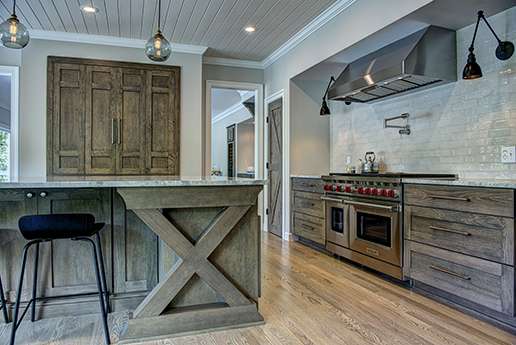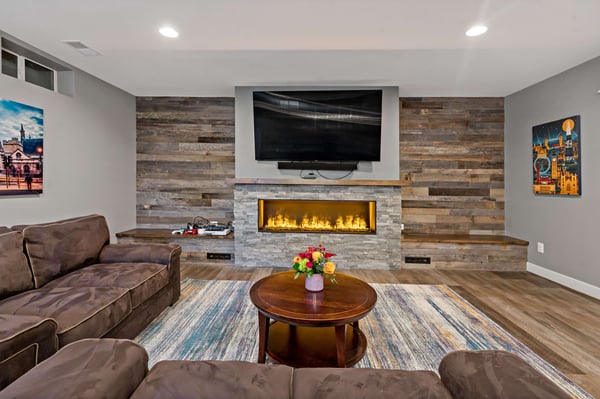
Rustic Retreats: Transforming Homes into Country Havens
Imagine stepping into a cozy, inviting space that exudes tranquility and warmth. Rustic design can transform any home into a country haven, providing a peaceful escape from the hustle and bustle of modern life. By incorporating natural materials, earthy colors, and comfortable furnishings, you can create a rustic retreat that embraces the beauty of nature. In this article, we will explore the key elements of rustic design, provide practical tips for planning your rustic transformation, discuss the selection of materials and textures, and delve into the world of rustic furniture and color schemes. Join us on this journey to discovering the charm of rustic retreats.
Understanding the Rustic Aesthetic
Before embarking on a rustic transformation of your home, it's essential to understand the aesthetic that defines this style. Rustic design draws inspiration from nature, emphasizing simplicity, authenticity, and natural beauty. It embraces imperfections and celebrates the rawness of materials, evoking a sense of timelessness and tranquility. Key elements that define the rustic aesthetic include natural textures, earthy colors, and a connection to the outdoors.
Key Elements of Rustic Design
Rustic design is characterized by certain key elements that help create its distinct aesthetic. Natural materials, such as wood and stone, play a vital role in rustic interiors. These materials bring warmth and texture to the space, creating a cozy and inviting atmosphere. The use of reclaimed or aged wood adds to the rustic charm, infusing the design with character and history. Another important element is the inclusion of organic textures, such as woven fabrics, rustic metals, and natural fibers.

The Appeal of Rustic Style
The appeal of rustic style lies in its ability to create a serene and welcoming environment. By incorporating elements inspired by nature, rustic design provides a break from the chaos of modern life. It allows us to reconnect with the simplicity and beauty of the natural world. Whether you live in a bustling city or a rural area, a rustic retreat can transport you to a tranquil countryside setting, even if just for a moment.
Imagine stepping into a rustic cabin nestled deep in the heart of a lush forest. The scent of pine fills the air, and the soft glow of a crackling fireplace warms the room. As you sink into a plush leather armchair, you can't help but notice the intricate details of the hand-carved wooden coffee table in front of you. Its rich, earthy tones and natural grain tell a story of craftsmanship and time-honored traditions.
Looking around, you see a cozy reading nook tucked away in the corner, adorned with plush cushions and a knitted blanket. The shelves are lined with weathered books, their pages yellowed with age, inviting you to escape into another world. The walls are adorned with rustic artwork, depicting scenes of rolling hills, babbling brooks, and majestic wildlife. It's as if nature has been invited indoors, creating a harmonious blend of the outside world and the comforts of home.
Planning Your Rustic Transformation
Embarking on a rustic transformation requires careful planning to ensure that your vision becomes a reality. Here are a few essential steps to consider:
Transforming your living space into a rustic haven involves more than just aesthetic changes; it's about creating a cozy and inviting atmosphere that reflects the beauty of nature. By incorporating natural elements like wood, stone, and earth tones, you can bring the warmth and charm of the outdoors inside.
.jpg?width=600&height=400&name=REA04887%20(1).jpg)
Assessing Your Space
Start by assessing your space and determining how the rustic aesthetic can be incorporated. Consider the size and layout of the room, as well as the existing architectural features. This will help you determine which elements of rustic design will work best in your home. Additionally, take note of any challenges or limitations that may need to be addressed during the transformation process.
Look for opportunities to enhance the natural light in your space, as it can play a significant role in creating an airy and open feel. Consider ways to maximize views of the outdoors, whether through strategically placed windows or by incorporating elements like indoor plants to bring a touch of greenery inside.
Setting a Budget
Setting a budget is an important step in any home transformation project. Determine how much you are willing to invest in creating your rustic retreat, taking into account materials, furnishings, and any professional help you may require. Having a clear budget in mind will guide your decision-making process and help you prioritize where to allocate funds.
When setting your budget, remember to factor in any unexpected costs that may arise during the renovation process. It's also a good idea to set aside a contingency fund to cover any unforeseen expenses that may pop up along the way. By planning ahead and being prepared, you can navigate the transformation process smoothly and with peace of mind.
Choosing Rustic Materials and Textures
When it comes to creating a rustic retreat, the choice of materials and textures is crucial. By selecting the right elements, you can bring the essence of nature indoors and create a harmonious and cohesive design. Let's explore two key components of rustic design: natural wood and stone, and fabric choices that enhance the rustic look.
Embracing a rustic design aesthetic goes beyond just selecting the right furniture pieces; it's about immersing yourself in a natural and earthy atmosphere. One way to achieve this is by incorporating elements of nature directly into your space. Consider adding potted plants, dried flowers, or even a small indoor herb garden to bring a touch of the outdoors inside. These living elements not only enhance the rustic vibe but also contribute to a sense of tranquility and well-being.

Natural Wood and Stone
Natural wood and stone are fundamental elements of rustic design. Wood, with its warm tones and grain patterns, adds instant rustic charm and creates a cozy atmosphere. Consider incorporating reclaimed or distressed wood for a more authentic look. Stone, whether it be on a fireplace, as a backsplash, or as accent walls, adds texture and character to your space, evoking the feeling of a cabin in the wilderness.
When working with natural wood and stone, don't be afraid to mix and match different finishes and textures. Combining rough-hewn beams with smooth river stones or pairing polished granite countertops with knotty pine cabinets adds depth and visual interest to your rustic decor. The juxtaposition of these materials creates a dynamic interplay that reflects the beauty of the natural world.

Fabric Choices for a Rustic Look
Choosing the right fabrics can enhance the rustic aesthetic of your home. Opt for natural materials, such as linen, cotton, and burlap, as they add warmth and texture. Woven fabrics, like cozy blankets and chunky knit throws, create a sense of comfort and invite relaxation. When selecting patterns, consider rustic motifs such as plaids, stripes, and nature-inspired prints, which further reinforce the connection to the outdoors.
To amplify the cozy and inviting feel of your rustic space, layering different textures and fabrics is key. Mix soft, plush materials like faux fur or sheepskin with rougher textures such as jute or canvas to create a tactile experience that engages all the senses. Adding throw pillows in varying fabrics and patterns not only enhances the visual appeal of your decor but also provides an opportunity to infuse pops of color and personality into the room.
Incorporating Rustic Furniture
One of the most exciting aspects of creating a rustic retreat is selecting the furniture that will bring your vision to life. By carefully choosing rustic furniture pieces, you can strike a balance between comfort and style, creating a space that is both functional and aesthetically pleasing.
Selecting the Right Pieces
When selecting rustic furniture, look for pieces that showcase natural materials and craftsmanship. Wooden furniture with distressed finishes or handcrafted details can add character to your space. Incorporate pieces with a rustic charm, such as a farmhouse dining table, a leather armchair, or a reclaimed wood coffee table. These pieces not only serve a practical purpose but also become focal points, welcoming you and your guests into your rustic retreat.
Balancing Comfort and Style
While rustic design often evokes a sense of simplicity, it's essential to prioritize comfort in your rustic retreat. Look for furniture that offers both visual appeal and comfort, such as plush sofas and chairs with soft upholstery. Introducing cozy textures through cushions and throws can further enhance the comfort of your rustic retreat, creating a space where you can unwind and relax.

Rustic Color Schemes
The colors you choose for your rustic retreat can greatly impact the overall ambiance and atmosphere. Rustic design favors earth tones and neutrals, which create a sense of warmth and grounding. Let's explore how these colors can be incorporated into your rustic transformation.
Earth Tones and Neutrals
Earth tones, such as warm browns, rich creams, and deep greens, form the foundation of rustic color schemes. These colors evoke a natural, organic feel and help create a cozy and inviting space. Beige and taupe can serve as versatile neutrals, providing a neutral backdrop that allows other rustic elements to shine. Consider incorporating natural materials in these earthy tones, such as wooden furniture and stone accents, to enhance the overall ambiance.
Pops of Color in Rustic Design
While rustic design often leans toward earthy tones, pops of color can add visual interest and personality to your space. Consider incorporating small accents in vibrant hues, such as burnt orange, deep red, or mustard yellow. These pops of color can be introduced through accessories like artwork, pillows, or rugs, creating focal points that add depth and character to your rustic retreat.

With the knowledge of the key elements, planning strategies, material and texture choices, and furniture and color selection, you are well-equipped to embark on your rustic transformation journey. By carefully curating each aspect of your rustic retreat, you can create a space that embraces the beauty of nature and provides a haven of tranquility and comfort within your own home. So, get ready to infuse your space with rustic charm and embark on this transformative adventure into the world of rustic design.
